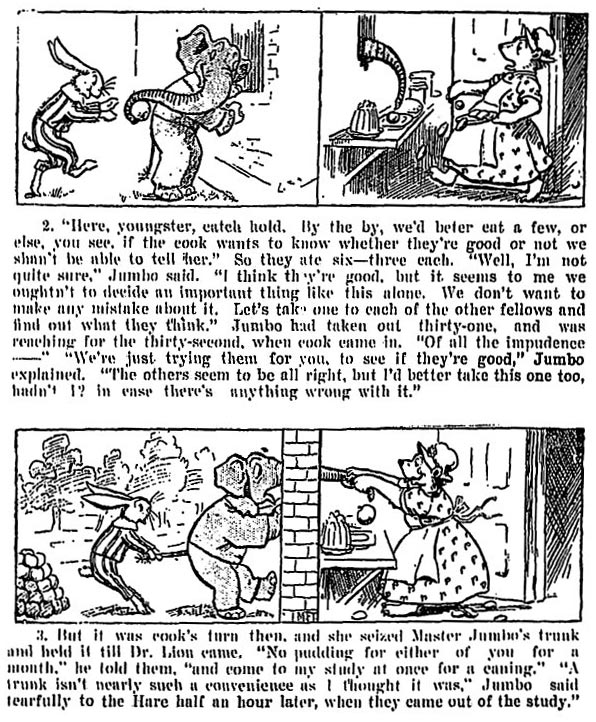'Rupert the Chick' (The Chick's Own, 3 March 1923).
Arthur White was an early 20th-century British comic artist, best remembered as the creator of the long-running series 'Jungle Jinks' (1898-1947). The first British "funny animal" comic strip in history, it was continued by other artists over the course of half a century. It was popular enough to inspire its own comic magazine and a spin-off, 'Dr. Lion's Boys' by White's successor Mabel Francis Taylor. By the time 'Jungle Jinks' ended its run, it was the longest-running British comic series ever, a record nowadays beaten by Julius Stafford Baker (II)'s 'Tiger Tim' (1904-1985) and Mary Tourtel's 'Rupert Bear' (1920). Yet White also created other long-running series like 'Fun on Board the Mary Anne' (1907-1921), 'Tom Bowline' (1909-1926) and 'Rupert the Chick' (1927-1957), all for the magazines of the Amalgamated Press.
Early life and career
Arthur White was born in 1881 on the Falkland Islands, the British colony beneath Argentina. His father was a gardener who moved back to London when little Arthur was two years old. White started his career in the 1890s, when his illustrations appeared in Alfred Harmsworth's children's magazines Boy's Friend, Boy's Realm, Boy's Herald, Union Jack and The Marvel. White was strongly influenced by Benjamin Rabier.
Jungle Jinks
On 29 October 1898 White created his signature series 'Jungle Jinks' for The Playbox, a supplement of the women's magazine Home Chat, also published by Harmsworth. The comic strip revolved around a group of children and their headmaster, who were all anthropomorphized as animals. The series caught on immediately, but White's run on the series was relatively short compared with his successor, Mabel Francis Taylor, who'd write and illustrate it for most of its nearly half-a-century run. She even created a spin-off, 'Dr. Lion's Boys' (1938), which ran in Happy Families, Home Chat and the series' own magazine, Jungle Jinks. The first issue of the Jungle Jinks magazine was published on 8 December 1923. It replaced the previous children's publication Chuckles, but nevertheless didn't last long. By 14 December 1925, Jungle Jinks magazine was already retitled as Playbox magazine.
'Jungle Jinks' from 1899, presumably by Arthur White.
'Jungle Jinks' had a large cast of main characters, among them Jumbo the elephant, Jacko the monkey, Hippo the hippopotamus, Bertie and Billie Boar (who were pig twins), Archie Alligator, Ping Panda, Aussie Koala and the headmaster Dr. Lion. Apart from its press longevity, 'Jungle Jinks' was historically important as the first British "funny animal" comic strip. Its success paved the way for a long stream of English comic strips about cute anthropomorphized animals, such as Julius Stafford Baker's 'The Bruin Boys' (better known as 'Tiger Tim', 1904-1985), Mabel Francis Taylor's 'The Little Sparrowkins' (1905), Charles Folkard's 'Teddy Tail' (1915-1974), Austin Bowen Payne's 'Pip, Squeak and Wilfred' (1919), Mary Tourtel's 'Rupert Bear' (1920), Harry Folkard's 'Billy Bimbo and Peter Porker' (1920), George Studdy's 'Bonzo the Dog' (1922), James Crighton's 'Korky the Cat' (1937), Reg Carter's 'Big Eggo' (1938) and Dudley D. Watkins' 'Biffo the Bear' (1948).
Other pre-World War I comics
White himself was guaranteed a long career in comics too, mostly devoted to the magazines of Alfred Harmsworth's Amalgamated Press (founded in 1901). He drew 'Chinwag the Cheerful' (1903) for Illustrated Chips and 'Flannelfeet' (1904) for Puck, while illustrating for Ally Sloper's Half Holiday as well. Among his longest-running comic series around this period were 'Fun on Board the Mary Anne' (1907-1921) for Comic Cuts and 'Tom Bowline' (1909-1926) for Illustrated Chips. He made the illustrations for the text serial 'The Pride of the Ring' (1907) in Jester, while 'Commodore Pott' (1905) appeared in Comic Cuts, 'Punch and Peter' (1909) saw print in Jester and Wonder and 'Honeysuckle Farm' (1914) ran in Halfpenny Wonder.
Post-World War I comics
After World War I, his art appeared generally in the AP's nursery titles, starting with 'Billy and Dolly Jumbo' (1919) in Playtime. In 1920 White created 'Jog and Trot the Jolly Dogs' (1920) for Wonderland Tales, a magazine for which he also illustrated the annual comic books until 1922. 1920 was also the same year 'Dicky the Duck' (1920) appeared in The Chick's Own, a children's magazine with comics about anthropomorphized baby birds. It was the first comic to be entirely printed in hyphenated syllables. His longest-running feature in this magazine was 'Rupert the Chick' (1927-1957), who appeared on every front cover until its final issue. In 1929 White created 'Punch and Judy' (1929) for Bo-Peep and Little Boy Blue. He also worked for the annuals of Wonderland (1921-1922), Mrs Hippo's (1920s, 1930s) and Bruin Boys (1930s).
Later life and death
By the 1940s White was treasurer of Damerham Baptist Church in his home village Hampshire. It is known that he kept active as an illustrator outside the comic world too. He once painted a mural for the Great Ormond Street Hospital, depicting Robinson Crusoe, and illustrated John Bunyan's 'Pilgrim's Progress' and the biblical story of the Good Samaritan. He died somewhere in the second half of the 20th century.
Legacy and influence
On his fourth birthday, in 1937, Quentin Blake received his first copy of the children's comic magazine The Chicks' Own. The boy was particularly captivated by the work of Arthur White. Blake kept this issue his entire life and decades later, devoted an article to it, 'A Book to Remember', published in The Guardian on 28 February 2001.





